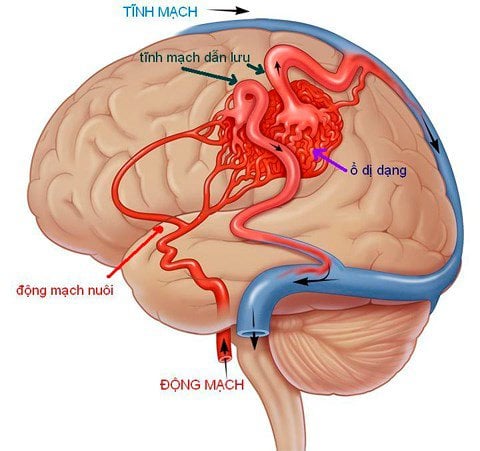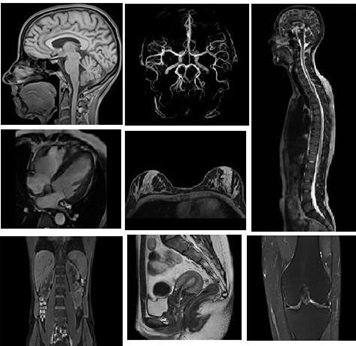Stroke - A dangerous complication of cerebrovascular malformation
This article is professionally consulted by Master, Doctor Bui Ngoc Phuong Hoa - General Internal Medicine - Department of Medical Examination & Internal Medicine - Vinmec Danang International Hospital. The doctor has more than 24 years of experience in the field of Psychiatry.
For people who have frequent headaches, signs of dizziness, need to go to the doctor because they may have a brain vascular malformation - a disease that causes a stroke very quickly.
1. Cerebral vascular malformation disease
Cerebrovascular malformation is a congenital disease, developing from the fourth to the eighth week of pregnancy, causing the artery to connect directly to the vein without an intermediate capillary network, so most of the malformations Cerebral blood vessels can remain in the brain for a long time without any symptoms.
Cerebrovascular malformation develops over time, persists asymptomatically for many years, and is detected mainly at the age of 45 years and under in 3 situations: cerebral hemorrhage (50-60%); headache, epilepsy (40-45%) or incidentally (5-10%). Some patients are diagnosed quite late (60-70 years old).
The estimated prevalence of cerebrovascular malformations is 18 in 100,000 people.
Cerebrovascular malformation develops over time, persists asymptomatically for many years, and is detected mainly at the age of 45 years and under in 3 situations: cerebral hemorrhage (50-60%); headache, epilepsy (40-45%) or incidentally (5-10%). Some patients are diagnosed quite late (60-70 years old).
The estimated prevalence of cerebrovascular malformations is 18 in 100,000 people.
2. Dangerous complications of cerebrovascular malformation
Complications of cerebrovascular malformation include:
When not broken: The patient presents with chronic headache, cannot be cured by medical treatment, has epileptic seizures. Cases of large deformed lesion size can cause cerebral compression and cerebral ischemia, causing paralysis of limbs... However, the disease may have no symptoms, only discovered by chance during CT scan, magnetic resonance or cerebral angiography. When ruptured: This is the most serious complication of the disease, it will cause hemorrhagic stroke, often bleeding in the brain parenchyma, may bleed into the ventricles or a combination, very rarely subarachnoid hemorrhage. Sudden, acute symptoms with varying severity with manifestations such as severe headache, vomiting, nausea, increased blood pressure, consciousness may be normal, or lethargy, even coma, paralysis Hemiplegia, difficulty speaking or not speaking... About two-thirds of people with this condition will have a stroke before the age of 40. Each year, about 4 out of 100 people with a cerebrovascular malformation will have a hemorrhage . With bleeding, there is a 15-20% risk of death or stroke, 30% of neurological disease, and 10% of death.
When not broken: The patient presents with chronic headache, cannot be cured by medical treatment, has epileptic seizures. Cases of large deformed lesion size can cause cerebral compression and cerebral ischemia, causing paralysis of limbs... However, the disease may have no symptoms, only discovered by chance during CT scan, magnetic resonance or cerebral angiography. When ruptured: This is the most serious complication of the disease, it will cause hemorrhagic stroke, often bleeding in the brain parenchyma, may bleed into the ventricles or a combination, very rarely subarachnoid hemorrhage. Sudden, acute symptoms with varying severity with manifestations such as severe headache, vomiting, nausea, increased blood pressure, consciousness may be normal, or lethargy, even coma, paralysis Hemiplegia, difficulty speaking or not speaking... About two-thirds of people with this condition will have a stroke before the age of 40. Each year, about 4 out of 100 people with a cerebrovascular malformation will have a hemorrhage . With bleeding, there is a 15-20% risk of death or stroke, 30% of neurological disease, and 10% of death.

Hình ảnh dị dạng mạch máu não
3. What to do when a patient has a stroke and is found to have a ruptured cerebrovascular malformation?
Each type of stroke is diagnosed and treated differently. Patients with signs of cerebral stroke should be taken immediately to the nearest hospital for examination and emergency treatment of respiratory and cardiovascular disorders and an emergency brain CT scan.
If there is brain bleeding, doctors will determine the type of brain bleeding and predict the cause to have the right and timely treatment. If cerebral parenchymal bleeding is caused by rupture of small vessels in patients with hypertension and atherosclerosis, cerebral angiography will not be required.
On the contrary, if bleeding due to cerebrovascular disease is considered, the patient should be transferred to a higher level as soon as possible for digital background angiography (DSA) and emergency treatment intervention.
Digital angiography technology to erase the background has helped doctors detect abnormal blood flow conditions early, helping to diagnose and treat serious diseases in the neurological field accurately. Anatomy plan and help pinpoint the exact location of the lesion inside the body.
Thanks to this DSA machine, quite a few cases of neurological diseases, especially cerebrovascular diseases, were clearly diagnosed and were quickly and promptly intervened within the golden period, so their lives were saved.
If there is brain bleeding, doctors will determine the type of brain bleeding and predict the cause to have the right and timely treatment. If cerebral parenchymal bleeding is caused by rupture of small vessels in patients with hypertension and atherosclerosis, cerebral angiography will not be required.
On the contrary, if bleeding due to cerebrovascular disease is considered, the patient should be transferred to a higher level as soon as possible for digital background angiography (DSA) and emergency treatment intervention.
Digital angiography technology to erase the background has helped doctors detect abnormal blood flow conditions early, helping to diagnose and treat serious diseases in the neurological field accurately. Anatomy plan and help pinpoint the exact location of the lesion inside the body.
Thanks to this DSA machine, quite a few cases of neurological diseases, especially cerebrovascular diseases, were clearly diagnosed and were quickly and promptly intervened within the golden period, so their lives were saved.
4. Methods of treating cerebrovascular malformations

Bác sĩ sẽ đưa ra cách điều trị tốt nhất phụ thuộc vào tình trạng của bệnh nhân
The doctor will recommend the best treatment depending on the patient's condition and this will be determined by the size of the deformity and its location. There are 3 treatment methods:
Endovascular embolization
In this technique, the doctor inserts a long, thin tube into an artery in the groin and threaded it through the blood vessel to the brain under the guidance of a doctor. X-ray images. A catheter is placed in one of the arteries feeding to the malformed blood vessel and an embolizer, such as small particles, glue-like substances, microcoils, or other materials, is injected, to block the artery and reduce blood flow. into the malformed blood vessel, causing endovascular occlusion is less invasive than traditional surgery. It can be done alone, but is often used before other surgical treatments to make the procedure safer by reducing the size of the malformed blood vessel or reducing the chance of bleeding.
Larger malformations and complex structures are often treated with a combination of methods. In these cases, doctors usually embolize the vessels first to reduce the size of the deformity, then open surgery or radiation surgery.
Depending on the overall condition and damage of each patient, the method and treatment plan will be selected in the most appropriate way.
Radiation therapy (Gamma Knife)
This is also known as radiation surgery or radiosurgery. A narrow X-ray beam focuses on the malformation so that the high dose targets the AVM and the rest of the brain suffers a much lower dose. This radiation causes the cerebral vascular malformation to contract and close over a period of 2-3 years in 80% of patients. The risk of complications from this procedure is low. Until the cerebrovascular malformation is completely closed, the risk of bleeding remains.
Surgery
This is the oldest method to treat cerebrovascular malformations. The malformation is removed in the operating room under general anesthesia. Open the skull, clamp and cut the malformed blood vessels. Usually applied when the ruptured malformation causes intracranial hematoma or the large malformation causes focal neurological signs. The risks of surgery are often high for cerebrovascular malformations located deep in the brain where vital functions are located.
Besides, there is another option of doing nothing and just monitoring the disease. Your doctor may recommend follow-up if they feel the treatment is unsafe or find out that you are older.
Endovascular embolization
In this technique, the doctor inserts a long, thin tube into an artery in the groin and threaded it through the blood vessel to the brain under the guidance of a doctor. X-ray images. A catheter is placed in one of the arteries feeding to the malformed blood vessel and an embolizer, such as small particles, glue-like substances, microcoils, or other materials, is injected, to block the artery and reduce blood flow. into the malformed blood vessel, causing endovascular occlusion is less invasive than traditional surgery. It can be done alone, but is often used before other surgical treatments to make the procedure safer by reducing the size of the malformed blood vessel or reducing the chance of bleeding.
Larger malformations and complex structures are often treated with a combination of methods. In these cases, doctors usually embolize the vessels first to reduce the size of the deformity, then open surgery or radiation surgery.
Depending on the overall condition and damage of each patient, the method and treatment plan will be selected in the most appropriate way.
Radiation therapy (Gamma Knife)
This is also known as radiation surgery or radiosurgery. A narrow X-ray beam focuses on the malformation so that the high dose targets the AVM and the rest of the brain suffers a much lower dose. This radiation causes the cerebral vascular malformation to contract and close over a period of 2-3 years in 80% of patients. The risk of complications from this procedure is low. Until the cerebrovascular malformation is completely closed, the risk of bleeding remains.
Surgery
This is the oldest method to treat cerebrovascular malformations. The malformation is removed in the operating room under general anesthesia. Open the skull, clamp and cut the malformed blood vessels. Usually applied when the ruptured malformation causes intracranial hematoma or the large malformation causes focal neurological signs. The risks of surgery are often high for cerebrovascular malformations located deep in the brain where vital functions are located.
Besides, there is another option of doing nothing and just monitoring the disease. Your doctor may recommend follow-up if they feel the treatment is unsafe or find out that you are older.
Currently, Magnetic Resonance Imaging - MRI/MRA is considered a "golden" tool to screen for brain stroke. MRI is used to check the condition of most organs in the body, especially valuable in detailed imaging of the brain or spinal nerves. Due to the good contrast and resolution, MRI images allow to detect abnormalities hidden behind bone layers that are difficult to recognize with other imaging methods. MRI can give more accurate results than X-ray techniques (except for DSA angiography) in diagnosing brain diseases, cardiovascular diseases, strokes,... Moreover, the process MRI scans do not cause side effects like X-rays or computed tomography (CT) scans.\
Vinmec International General Hospital currently owns a 3.0 Tesla MRI system equipped with state-of-the-art equipment by GE. Healthcare (USA) with high image quality, allows comprehensive assessment, does not miss the injury but reduces the time taken to take pictures. Silent technology helps to reduce noise, create comfort and reduce stress for the client during the shooting process, resulting in better image quality and shorter imaging time. With the state-of-the-art MRI system With the application of modern methods of cerebral vascular intervention, a team of experienced and well-trained neurologists and radiologists, Vinmec is a prestigious address for stroke risk screening and screening. reliable goods.
In the past time; Vinmec has successfully treated many cases of stroke in a timely manner, leaving no sequelae: saving the life of a patient suffering from 2 consecutive strokes; Responding to foreign female tourists to escape the "death door" of a stroke;...
Vinmec International General Hospital currently owns a 3.0 Tesla MRI system equipped with state-of-the-art equipment by GE. Healthcare (USA) with high image quality, allows comprehensive assessment, does not miss the injury but reduces the time taken to take pictures. Silent technology helps to reduce noise, create comfort and reduce stress for the client during the shooting process, resulting in better image quality and shorter imaging time. With the state-of-the-art MRI system With the application of modern methods of cerebral vascular intervention, a team of experienced and well-trained neurologists and radiologists, Vinmec is a prestigious address for stroke risk screening and screening. reliable goods.
In the past time; Vinmec has successfully treated many cases of stroke in a timely manner, leaving no sequelae: saving the life of a patient suffering from 2 consecutive strokes; Responding to foreign female tourists to escape the "death door" of a stroke;...
Để đặt lịch khám tại viện, Quý khách vui lòng bấm số HOTLINE hoặc đặt lịch trực tiếp TẠI ĐÂY. Tải và đặt lịch khám tự động trên ứng dụng MyVinmec để quản lý, theo dõi lịch và đặt hẹn mọi lúc mọi nơi ngay trên ứng dụng.
Bài viết này được viết cho người đọc tại Sài Gòn, Hà Nội, Hồ Chí Minh, Phú Quốc, Nha Trang, Hạ Long, Hải Phòng, Đà Nẵng.






